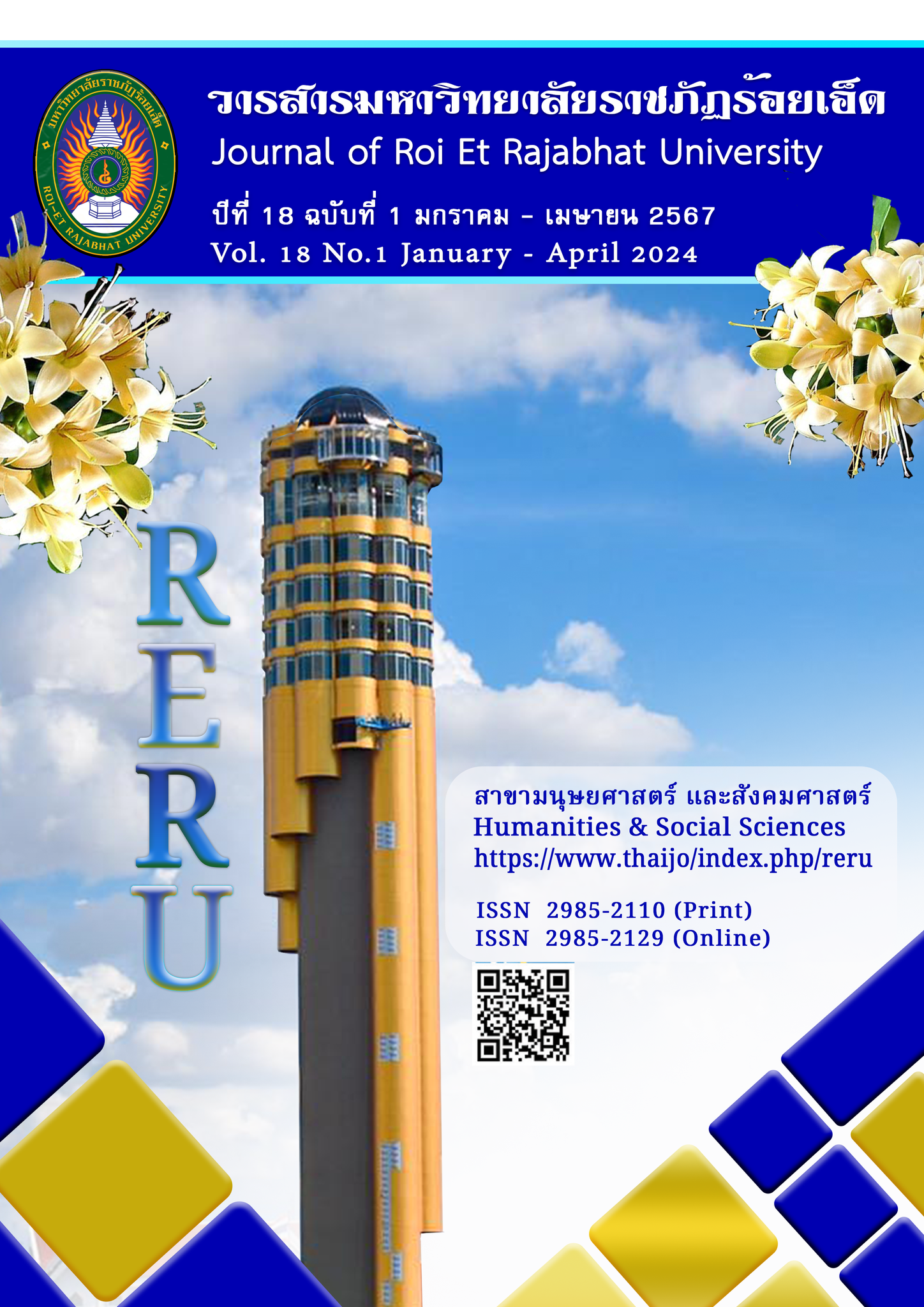The Development of Fingerstyle Guitar’s Exercise for the Students in Major of Popular String Instruments, Bachelor of Education, Roi Et Rajabhat University
Keywords:
Exercise, Fingerstyle guitar, The Major of Popular String InstrumentsAbstract
The objectives of this research were: 1) to develop exercises for fingerstyle guitar playing skills using percussive techniques to achieve efficiency according to the 80/80 criteria, 2) to develop fingerstyle guitar playing skills by incorporating percussive techniques of popular string instrument students, Bachelor of Education, Faculty of Education, Roi Et Rajabhat University to achieve the 80% assessment criteria.
The sample included 6 third-year students in the Bachelor of Education curriculum, majoring in popular string instruments of the music education program, Faculty of Education, at Roi Et Rajabhat University.
The research instrument utilized was comprised of: 1) Exercises for fingerstyle guitar playing skills for third year students majoring in popular string instruments, Faculty of Education, Roi Et Rajabhat University. 2) The popular string instruments skill assessment form for the third-year students gathered data through video recording, observation, questioning, interviewing, and evaluation based on the criteria. The statistical data was analyzed
by using percentage, average, and standard deviation. The research results found that:
1) The efficiency of the fingerstyle guitar playing skill practice by using percussive techniques was 81.74/80.95, which was higher than the criteria of 80/80. 2) Developing fingerstyle guitar playing skills by using percussive techniques of students majoring in popular string instruments, Bachelor of music education curriculum, Faculty of Education, Roi Et Rajabhat University, passed the evaluation criteria with 80 percent. The fourth cycle which was the final cycle of the action research found that the average score of the 6 students was higher than 80%, the lowest average score was 85.71% and the highest score was 95.23%.
References
จิราภรณ์ ทองพูล, ปกรณ์ชัย สุพัฒน์, เมธี วิสาพรหม และจิตติมาภรณ์ สีหะวงษ์. (2563). การพัฒนาสมรรถนะในการอ่านคำ
ควบกล้ำด้วยการจัดการเรียนรู้ Active Learning รูปแบบ GWM ของนักเรียนชั้นประถมศึกษาปีที่ 4 โรงเรียนขุมคำวิทยา
สพป.ศก.1. วารสารมหาวิทยาลัยราชภัฏร้อยเอ็ด, 14(1), 3-14.
ชัยยงค์ พรหมวงศ์. (2556). การทดสอบประสิทธิภาพสื่อหรือชุดการสอน. วารสารศิลปากรศึกษาศาสตร์วิจัย, 5(1), 5-20.
นิตยา อินทรักษ์. (2551). ผลของการฝึกทักษะดูแลโดยใช้ตัวแบบวีดิทัศน์สำหรับผู้ดูแลต่อความวิตกกังวลของผู้ดูแลผู้สูงอายุ โรคหลอดเลือดสมอง. วิทยานิพนธ์ พยาบาลศาสตรมหาบัณฑิต สาขาวิชาพยาบาลศาสตร์. กรุงเทพฯ: จุฬาลงกรณ์
มหาวิทยาลัย.
นวพรรษ ศุภวรางกูล และอุษณี ลลิตผสาน. (2565). การวิจัยเชิงปฏิบัติการเพื่อพัฒนาผลสัมฤทธิ์ทางการเรียนวิชาสังคมศึกษา
เรื่องเครื่องมือทางภูมิศาสตร์ของนักเรียนระดับชั้นมัธยมศึกษาปีที่ 3 ที่ได้รับการจัดการเรียนรู้โดยใช้เทคนิคผังกราฟิก.
วารสารสังคมศาสตร์ มหาวิทยาลัยศรีนครินทรวิโรฒ, 25(1), 38-49.
บพิตร เค้าหัน. (2561). แนวทางการเรียบเรียงเสียงประสานบทเพลงพระราชนิพนธ์ในพระบาทสมเด็จพระปรมินทรมหาภูมิพล
อดุลยเดชบรมนาถบพิตรตามระเบียบกรมราชเลขานุการในพระองค์. วารสารมหาวิทยาลัยราชภัฏร้อยเอ็ด, 12(2),
-281.
ภูวดล อัคนิถิน. (2556). การพัฒนาทักษะบรรเลงเครื่องดนตรีโดยใช้เทคนิคการสอนแบบมัลติมีเดีย. เชียงใหม่: มหาวิทยาลัยพายัพ.
เลิศ อานันทนะ. (2537). ทัศนคติใช้สื่อการสอนระดับประถมศึกษา. กรุงเทพฯ: มหาวิทยาลัยสุโขทัยธรรมาธิราช.
วรรณาภรณ์ พระเมเด, ไพศาล วรคำ และอาทิตย์ อาจหาญ. (2562). การพัฒนาชุดฝึกทักษะการอ่านและการเขียนภาษาไทย
เพื่อแก้ปัญหาการอ่านไม่ออกเขียนไม่ได้ของนักเรียนระดับชั้นประถมศึกษาปีที่ 5. วารสารมหาวิทยาลัยราชภัฏร้อยเอ็ด, 13(3), 85-93.
วิมลรัตน์ สุนทรวิโรจน์. (2553). การออกแบบการเรียนรู้ตามแนวคิด Backward Design. มหาสารคาม: มหาวิทยาลัยมหาสารคาม.
สัจธรรม พรทวีกุล. (2562). การพัฒนารูปแบบการเรียนการสอนโดยใช้โครงงานเป็นฐานผสมผสานคิดไตร่ตรองเพื่อพัฒนาความสามารถในการกำกับการเรียนรู้ของตนเอง สำหรับนักศึกษาสาขาดนตรีศึกษา มหาวิทยาลัยราชภัฏร้อยเอ็ด. วารสารศึกษาศาสตร์ มหาวิทยาลัยขอนแก่น, 42(3), 69-83.
สันติ มุสิกา. (2565). การพัฒนาชุดฝึกทักษะการปฏิบัติกีต้าร์เบื้องต้นระดับชั้นมัธยมศึกษาปีที่ 4 โรงเรียนโพธิ์ไทรพิทยาคาร. วารสาร มจร.อุบลปริทรรศน์, 7(2), 2009–2022.
สุรางค์ โค้วตระกูล. (2553). จิตวิทยาการศึกษา (พิมพ์ครั้งที่9). กรุงเทพฯ: สำนักพิมพ์แห่งจุฬาลงกรณ์มหาวิทยาลัย
อธิวัฒน์ พรหมจันทร์ และอินทิรา รอบรู้. (2561). การพัฒนาชุดการเรียนการเล่นกีตาร์ขั้นพื้นฐานสำหรับนักเรียน
ชั้นประถมศึกษาปีที่ 5 โรงเรียนเทพวิทยา. วารสารชุมชนวิจัย มหาวิทยาลัยราชภัฏนครราชสีมา, 12(3), 200–210.
ฮามีร อ่อนทอง, เอกชัย พุหิรัญ, พิมลมาศ พร้อมสุขกุล และรุ่งเกียรติ สิริวงษ์สุวรรณ. (2563). การจัดการเรียนการสอน
วิชากีตาร์เบสสมัยนิยมระดับอุดมศึกษา ในเขตกรุงเทพมหานครและปริมณฑล. วารสารสหศาสตร์มหาวิทยาลัยมหิดล,
(2), 119-130.
Auciello, E. (2021). The Idiophonic Guitar: A Taxonomy and Performance Guide to Percussive Effects in
the Classical Guitar’s Solo Repertoire. Master of Philosophy Elder Conservatorium of Music
Faculty of Arts The University of Adelaide, 22-29.
Hirschelman, E. (2011). Acoustic Artistry: Tapping, Slapping, and Percussion Techniques for Classical &
Fingerstyle Guitar. Milwaukee: Halleonard Corporation.
Kellie, D. (2018). Advanceed Acoustic Fingerstyle Guitar. New York: Fundamental changes.
Kemmis, S and McTaggart, R. (1988). The Action Research Planer (3rd ed.). Victoria: Deakin University.
Rivera, M. (2018). The Percussive Acoustic Guitar Method. Madrid: Independently Publisher.
Chapman, R. (2003). The New Complete Guitarist. London: Dorling Kindsley.
Trinity, G. (2018). Guitar Syllabus. London: Trinity College London.
Woods, C. (2013). Percussive Acoustic Guitar. Milwaukee: Halleonard Corporation.
Downloads
Published
How to Cite
Issue
Section
License
Copyright (c) 2024 Roi Et Rajabhat University

This work is licensed under a Creative Commons Attribution-NonCommercial-NoDerivatives 4.0 International License.
บทความที่ได้รับการตีพิมพ์เป็นลิขสิทธิ์ของวารสารมหาวิทยาลัยราชภัฎร้อยเอ็ด
ข้อความที่ปรากฏในบทความแต่ละเรื่องในวารสารวิชาการเล่มนี้เป็นความคิดเห็นส่วนตัวของผู้เขียนแต่ละท่านไม่เกี่ยวข้องกับมหาวิทยาลัยราชภัฎร้อยเอ็ด และคณาจารย์ท่านอื่นๆในมหาวิทยาลัยฯ แต่อย่างใด ความรับผิดชอบองค์ประกอบทั้งหมดของบทความแต่ละเรื่องเป็นของผู้เขียนแต่ละท่าน หากมีความผิดพลาดใดๆ ผู้เขียนแต่ละท่านจะรับผิดชอบบทความของตนเองแต่ผู้เดียว





